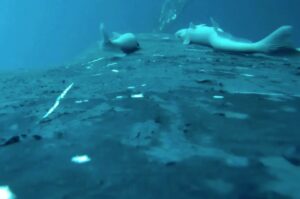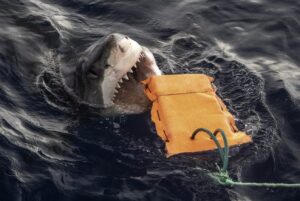Scientists have found a whole new world beneath the Pacific Ocean. Underwater robots removed layers of the seafloor to see what lurked there. After stripping back the layers, they discovered a new ecosystem teeming with unknown species.
The research team was looking underneath hydrothermal vents on the East Pacific Rise off the coast of Central America. Hydrothermal vents — hot springs in the deep sea — were first discovered in 1977. The mineral-laden water attracts abundant life, despite extreme temperatures and a lack of sunlight. Until now, no one thought to look beneath them.

An eelpout swims by a tower of tubeworms at the Tica Vent, a site on the East Pacific Rise. Photo: Schmidt Ocean Institute
Life in incredible places
Using a robotic arm to flip over bits of the sea floor, the researchers found cave systems filled with a subsurface fluid. A network of cracks and crevices created a maze in which worms, snails, microscopic larvae, and bacteria are flourishing.
“This truly remarkable discovery of a new ecosystem, hidden beneath another ecosystem, provides fresh evidence that life exists in incredible places,” said Jyotika Virmani, director of the Schmidt Ocean Institute.
The Schmidt Ocean Institute began by studying the species on the East Pacific Rise. The rise is home to several deep-sea volcanoes that formed on the border between tectonic plates. Despite dark, cold conditions, the area is a biodiversity hotspot because of bacteria that convert minerals from the thermal springs into sugars used by other animals.
Giant tube worms
Giant tube worms are one of the most successful species around the vents. Even when volcanic activity appeared to wipe them out, they would reappear at newly formed hydrothermal vents. Scientists were intrigued. How did the giant worms colonize new areas so quickly?
Compounding the mystery, researchers rarely saw tube worm larvae around the vents, only adult worms. The scientists began to suspect the larvae were appearing from cracks in the sea floor.
To test the theory, the underwater robot glued a mesh box over cracks in the seafloor next to the Tica hydrothermal vent. When they looked inside, they found a variety of sea creatures. The only way the animals could have entered was from underneath the box.
Next, they scraped back bits of the seafloor, confirming that cavities exist below it. The team thinks that the tubeworms travel under the earth’s surface in vent fluid to colonize new vents.

Mesh boxes are sealed to the seafloor at the Tica Vent, a site on the East Pacific Rise. Photo: Schmidt Ocean Institute
“Two dynamic vent habitats exist,” said ecologist Monika Bright, a member of the research team. “Vent animals above and below the surface thrive together in unison, depending on vent fluid from below, and oxygen in the seawater from above.”
The team will publish its full findings later this year. “The discovery of new creatures, landscapes, and an entirely new ecosystem, underscores just how much we have yet to discover about our ocean,” said Wendy Schmidt, founder and president of the Schmidt Ocean Institute.






